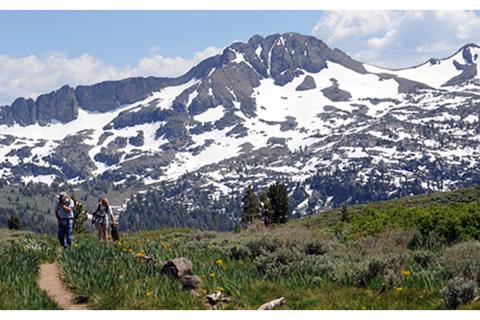
Preparing for a mountain camping trip, even in summer, requires careful consideration. Afternoon squalls are common in the Rocky Mountains as well as in the Sierra Nevada, and can bring rain, hail, sleet, high winds and snow even in the middle of July or August. Temperatures can roller-coaster 50 degrees or more during the course of a day, and altitude sickness affects some people even below 5,000 feet. Whether you’re car camping or backpacking, thinking ahead and preparing for all eventualities is essential. Here are some tips.
1. For people who live at or near sea level, a trip to the mountains can bring on headache, nausea, dehydration, sleeplessness, fatigue and other classic signs of altitude sickness. That’s why, whether you drive or fly to a mountain destination, it’s wise to take a day or two to acclimate before undertaking strenuous activity. The atmosphere at 5,000 feet contains 17 percent less oxygen than at sea level, and the air gets thinner the higher you go. Your body needs time to build more red blood cells to compensate for the corresponding lack of oxygen. Be mindful of your body’s response to elevation, and know that, for reasons unknown, some people are affected more than others.
2. As your body adjusts to higher altitude, your breathing quickens and your kidneys produce more urine. Even if you’re in great shape, you’re likely to feel out of kilter for a few days. It’s important to pump liquids, especially water, to mitigate the higher urine output as well as to compensate for the effects of dry mountain air. Sweat at altitude evaporates as quickly as it is produced, and you can lose a lot of body fluid without noticing. And be sure to slather on the sunscreen: the thinner the atmosphere, the more intense the UV rays.
3. Layered clothing is the secret to comfort when camping at altitude. Bring a combination, from base to shell, that can be peeled off and layered back on to meet a wide variety of thermodynamic conditions.
4. Regardless of the weather forecast, always bring rain gear on a mountain camping trip, and don’t leave your campsite without it, even on a half-day hike. It doesn’t take but a brief drenching to bring on hypothermia, and rain clouds can build and let loose long before you have time to find shelter. At the very least, carry a rain poncho.
5. Max out your tent set-up. Stake it out, put on the fly and otherwise prepare as though high winds and rain are on the horizon. Button down your tablecloth and other potentially fly-away items, too. Very likely, you’ll be glad you did.
6. Know how to get the most out of your sleeping bag. That zipper at the bottom? If you’re hot, zip it open up to your knees. You’ll be surprised at how much ventilation control you have if you just play around with the zippers. Even a zero-degree bag can be comfortable in 70-degree weather when it’s properly adjusted.
7. In cold temperatures, sleep atop two insulated pads instead of one. Wear at hat and wool socks or down booties to bed, and zip the hood tight around your face.
8. Hate crawling into a cold sleeping bag? Fill a Nalgene bottle with hot water, tuck it into the foot of your bag and your tootsies will stay toasty all night. A foil-wrapped potato baked in the coals of a campfire and wrapped in a towel can also serve as a great heating pad. But don’t use hot rocks: they hold heat too long and can scorch through a bag’s nylon fabric, potentially smoldering and causing a fire.
9. At altitudes above 3,000 feet, lower atmospheric pressure than at sea level causes water and other liquids to evaporate faster and boil at lower temperatures. The higher you go, the more adjustments you’ll need to make as to what and how you cook. Eggs will take longer to boil, for example, stews will take longer to cook and pasta will need to be prepared at a hard boil for a longer time with more than the usual amount of water to reach the proper consistency. Dehydrated backpacking meals should be soaked before cooking to prevent them from coming out watery.
10. Your sea-level camp stove may not work as efficiently at altitude. Read the directions and make the necessary adjustments if possible.
- 2420 views

